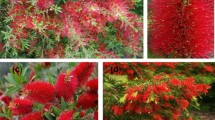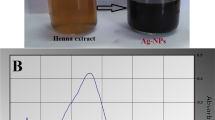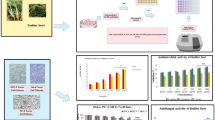Abstract
Tectona grandis Linn, commonly known as teak, is traditionally used to treat a range of diseases, including the common cold, headaches, bronchitis, scabies, diabetes, inflammation, and others. The present study was conducted with the purpose of isolating and identifying the active compounds in T. grandis leaf against a panel of Vibrio spp., which may induce vibriosis in shrimp, using bioassay-guided purification. The antimicrobial activity was assessed using the microdilution method, followed by the brine shrimp lethality assay to determine toxicity. Following an initial screening with a number of different solvents, it was established that the acetone extract was the most effective. The acetone extract was then exposed to silica gel chromatography followed by reversed-phase HPLC and further UHPLC-orbitrap-ion trap mass spectrometry to identify the active compounds. Three compounds called 1-hydroxy-2,6,8-trimethoxy-9,10-anthraquinone, deoxyanserinone B, and khatmiamycin were identified with substantial anti-microbial action against V. parahaemolyticus, V. alginolyticus, V. harveyi, V. anguillarum, and V. vulnificus. The IC50 values of the three compounds viz. 1-hydroxy-2,6,8-trimethoxy-9,10-anthraquinone, deoxyanserinone B, and khatmiamycin varied between 2 and 28, 7 and 38, and 7 and 56 μg/mL, respectively, which are as good as the standard antibiotics such as amoxicillin and others. The in vivo toxicity test revealed that the compounds were non-toxic to shrimp. The results of the study suggest that T. grandis leaf can be used as a source of bioactive compounds to treat Vibrio species in shrimp farming.

Similar content being viewed by others
References
Abdalla MA, Win HY, Islam M, Von Tiedemann A, Schüffler A, Laatsch H (2011) Khatmiamycin, a motility inhibitor and zoosporicide against the grapevine downy mildew pathogen Plasmopara viticola from Streptomyces sp. ANK313. J Antibiot 64(10):655–659
Abdel-Latif HM, Yilmaz E, Dawood MA, Ringø E, Ahmadifar E, Yilmaz S (2022) Shrimp vibriosis and possible control measures using probiotics, postbiotics, prebiotics, and synbiotics: a review. Aquaculture:737951
Almalki MA (2020) Isolation and characterization of polyketide drug molecule from Streptomyces species with antimicrobial activity against clinical pathogens. J Infect Public Health 13(1):125–130
Apu AS, Muhit MA, Tareq SM, Pathan AH, Jamaluddin ATM, Ahmed M (2010) Antimicrobial activity and brine shrimp lethality bioassay of the leaves extract of Dillenia indica Linn. J Young Pharm 2(1):50–53
Arasu MV, Duraipandiyan V, Ignacimuthu S (2013) Antibacterial and antifungal activities of polyketide metabolite from marine Streptomyces sp. AP-123 and its cytotoxic effect. Chemosphere 90(2):479–487
Asdaq SMB, Nayeem N, Alam MT, Alaqel SI, Imran M, Hassan EWE, Rabbani SI (2022) Tectona grandis Lf: a comprehensive review on its patents, chemical constituents, and biological activities. Saudi J Biol Sci 29(3):1456–1464
Barros IBD, Daniel JFDS, Pinto JP, Rezende MI, Braz Filho R, Ferreira DT (2011) Phytochemical and antifungal activity of anthraquinones and root and leaf extracts of Coccoloba mollis on phytopathogens. Braz Arch Biol Technol 54:535–541
Bitchagno GTM, Sama Fonkeng L, Kopa TK, Tala MF, Kamdem Wabo H, Tume CB et al (2015) Antibacterial activity of ethanolic extract and compounds from fruits of Tectona grandis (Verbenaceae). BMC Complement Altern Med 15:1–6
Cabello FC, Godfrey HP, Tomova A, Ivanova L, Dölz H, Millanao A, Buschmann AH (2013) Antimicrobial use in aquaculture re-examined: its relevance to antimicrobial resistance and to animal and human health. Environ Microbiol 15(7):1917–1942
Cai L, Wei GX, van der Bijl P, Wu CD (2000) Namibian chewing stick, Diospyros lycioides, contains antibacterial compounds against oral pathogens. J Agric Food Chem 48(3):909–914
Chandrakala N, Priya S (2017) Vibriosis in shrimp aquaculture a review. Int J Sci Res Sci Eng Techno 3(2):27–33
Chatterjee S, Haldar S (2012) Vibrio related diseases in aquaculture and development of rapid and accurate identification methods. J Mar Sci: Res Dev 1:1–7
Didry N, Dubreuil L, Pinkas M (1994) Activity of anthraquinonic and naphthoquinonic compounds on oral bacteria. Die Pharmazie 49(9):681–683
Ejele AE, Akalezi CI, Iwu IC, Ukiwe LN, Enenebaku CK, Ngwu SU (2014) Bioassay-guided isolation, purification and charaterization of antimicrobial compound from acidic metabolite of Piper umbellatum seed extract. Int J Chem 6(1):61–70
El-Saadony MT, Swelum AA, Ghanima MMA, Shukry M, Omar AA, Taha AE et al (2022) Shrimp production, the most important diseases that threaten it, and the role of probiotics in confronting these diseases: a review. Res Vet Sci 144(1):126–140
Famuyide IM, Aro AO, Fasina FO, Eloff JN, McGaw LJ (2019) Antibacterial and antibiofilm activity of acetone leaf extracts of nine under-investigated South African Eugenia and Syzygium (Myrtaceae) species and their selectivity indices. BMC Complement Altern Med 19(1):1–13
Flegel TW (2012) Historic emergence, impact and current status of shrimp pathogens in Asia. J Invertebr Pathol 110(2):166–173
Flores-Sanchez IJ, Verpoorte R (2009) Plant polyketide synthases: a fascinating group of enzymes. Plant Physiol Biochem 47(3):167–174
Funt RC, Martin J (1993) Black walnut toxicity to plants, humans and horses. Ohio State University extension fact sheet HYG-1148-93
Ghosh AK, Panda SK, Luyten W (2021) Anti-vibrio and immune-enhancing activity of medicinal plants in shrimp: a comprehensive review. Fish Shellfish Immunol 117:192–210
Han J, Zhang J, He W, Huang P, Oyeleye A, Liu X, Zhang L (2015) Bioassay-guided identification of bioactive molecules from traditional Chinese medicines. In: Chemical biology. Humana Press, New York, NY, pp 187–196
Hossain A, Habibullah-Al-Mamun M, Nagano I, Masunaga S, Kitazawa D, Matsuda H (2022) Antibiotics, antibiotic-resistant bacteria, and resistance genes in aquaculture: risks, current concern, and future thinking. Environ Sci Pollut Res:1–22
Hu H, Hu C, Peng J, Ghosh AK, Khan A, Sun D, Luyten W (2021) Bioassay-guided interpretation of antimicrobial compounds in Kumu, a TCM preparation from Picrasma quassioides’ stem via UHPLC-orbitrap-ion trap mass spectrometry combined with fragmentation and retention time calculation. Front Pharmacol 12
Huang Q, Lu G, Shen HM, Chung MC, Ong CN (2007) Anti-cancer properties of anthraquinones from rhubarb. Med Res Rev 27(5):609–630
Iswarya A, Marudhupandi T, Vaseeharan B, Ibrahim WNW, Leong LK, Musa N (2022) Shrimp vibriosis. In: Aquaculture pathophysiology. Academic Press, pp 191–206
Kamsu GT, Djamen Chuisseu DP, Fodouop Chegaing SP, Laure Feudjio HB, Ndel Famen LC, Kodjio N et al (2021) Toxicological profile of the aqueous extract of Tectona grandis lf (Verbenaceae) leaves: a medicinal plant used in the treatment of typhoid fever in traditional Cameroonian medicine. J Toxicol 2021:10
Kerkoub N, Panda SK, Yang MR, Lu JG, Jiang ZH, Nasri H, Luyten W (2018a) Bioassay-guided isolation of anti-Candida biofilm compounds from methanol extracts of the aerial parts of Salvia officinalis (Annaba, Algeria). Front Pharmacol 9:1418
Khan NT (2019) Anthraquinones-a naturopathic compound. J New Dev Chem 2(2):25
Klaus V, Hartmann T, Gambini J, Graf P, Stahl W, Hartwig A, Klotz LO (2010) 1, 4-Naphthoquinones as inducers of oxidative damage and stress signaling in HaCaT human keratinocytes. Arch Biochem Biophys 496(2):93–100
Kopa TK, Tchinda AT, Tala MF, Zofou D, Jumbam R, Wabo HK et al (2014) Antiplasmodial anthraquinones and hemisynthetic derivatives from the leaves of Tectona grandis (Verbenaceae). Phytochem Lett 8:41–45
Krishna MS, Jayakumaran NA (2010) Antibacterial, cytotoxic and antioxidant potential of different extracts from leaf, bark and wood of Tectona grandis. Int J Pharm Sci Drug Res 2(2):155–158
Krüger H, Schulz H (2007) Analytical techniques for medicinal and aromatic plants. Stewart Postharvest Rev 3(4):1–12
Kumar V, Roy S (2017) Aquaculture drugs: sources, active ingredients, pharmaceutic preparations and methods of administration. J Aquac Res Dev 8:510
Lacret R, Varela RM, Molinillo JM, Nogueiras C, Macías FA (2011) Anthratectone and naphthotectone, two quinones from bioactive extracts of Tectona grandis. J Chem Ecol 37:1341–1348
Lee D, Yu YB, Choi JH, Jo AH, Hong SM, Kang JC, Kim JH (2022) Viral shrimp diseases listed by the OIE: a review. Viruses 14(3):585
Limbu SM, Zhou L, Sun SX, Zhang ML, Du ZY (2018) Chronic exposure to low environmental concentrations and legal aquaculture doses of antibiotics cause systemic adverse effects in Nile tilapia and provoke differential human health risk. Environ Int 115:205–219
Liu M, Veryser C, Lu JG, Wenseleers T, De Borggraeve WM, Jiang ZH, Luyten W (2018) Bioassay-guided isolation of active substances from Semen Torreyae identifies two new anthelmintic compounds with novel mechanism of action. J Ethnopharmacol 224:421–428
Lu X, Qi JK, Tang XY, Ye CT, Bai J, Tang C et al (2023) Polyketides with anti-inflammatory activity isolated from Rhodiola tibetica endophytic fungus Penicillium sp. HJT-A-10. Fitoterapia 164:105361
Manojlovic NT, Solujic S, Sukdolak S (2002) Antimicrobial activity of an extract and anthraquinones from Caloplaca schaereri. Lichenologist 34(1):83–85
Moshi MJ, Innocent E, Magadula JJ, Otieno DF, Weisheit A, Mbabazi PK, Nondo RSO (2010) Brine shrimp toxicity of some plants used as traditional medicines in Kagera Region, North Western Tanzania. Tanzan J Health Res 12(1):63–67
Neamatallah A, Yan L, Dewar SJ, Austin B (2005) An extract from teak (Tectona grandis) bark inhibited Listeria monocytogenes and methicillin resistant Staphylococcus aureus. Lett Appl Microbiol 41(1):94–96
O'brien J, Wilson I, Orton T, Pognan F (2000) Investigation of the alamar blue (resazurin) fluorescent dye for the assessment of mammalian cell cytotoxicity. Eur J Biochem 267(17):5421–5426
Panda SK, Mohanta YK, Padhi L, Luyten W (2019) Antimicrobial activity of select edible plants from Odisha, India against food-borne pathogens. LWT 113:108246
Panda SK, Padhi L, Leyssen P, Liu M, Neyts J, Luyten W (2017) Antimicrobial, anthelmintic, and antiviral activity of plants traditionally used for treating infectious disease in the Similipal Biosphere Reserve, Odisha, India. Front Pharmacol 8:658
Rahamouz-Haghighi S, Bagheri K, Sharafi A, Tavakolizadeh M, Mohsen-Pour N (2022) Phytochemical screening and cytotoxicity assessment of Plantago lanceolata L. root extracts on colorectal cancer cell lines and brine shrimp larvae and determination of the median lethal dose in mice. S Afr J Bot 149:740–747
Ravichandiran P, Sheet S, Premnath D, Kim AR, Yoo DJ (2019) 1, 4-Naphthoquinone analogues: potent antibacterial agents and mode of action evaluation. Molecules 24(7):1437
Sasidharan S, Chen Y, Saravanan D, Sundram KM, Latha LY (2011) Extraction, isolation and characterization of bioactive compounds from plants’ extracts. Afr J Tradit Complement Altern Med 8(1):1–10
Shukla N, Kumar M, Akanksha, Ahmad G, Rahuja N, Singh AB et al (2010) Tectone, a new antihyperglycemic anthraquinone from Tectona grandis leaves. Nat Prod Commun 5(3)
Singh R, Chauhan SMS (2004) 9, 10-Anthraquinones and other biologically active compounds from the genus Rubia. Chem Biodivers 1(9):1241–1264
Tamokou JDD, Tala MF, Wabo HK, Kuiate JR, Tane P (2009) Antimicrobial activities of methanol extract and compounds from stem bark of Vismia rubescens. J Ethnopharmacol 124(3):571–575
Tanih NF, Ndip RN (2012) Evaluation of the acetone and aqueous extracts of mature stem bark of Sclerocarya birrea for antioxidant and antimicrobial properties. Evid Based Complementary Altern Med 2012
Ullah MO, Haque M, Urmi KF, Zulfiker AHM, Anita ES, Begum M, Hamid K (2013) Anti-bacterial activity and brine shrimp lethality bioassay of methanolic extracts of fourteen different edible vegetables from Bangladesh. Asian Pac J Trop Biomed 3(1):1–7
Van Puyvelde L, Aissa A, Panda SK, De Borggraeve WM, Mukazayire MJ, Luyten W (2021) Bioassay-guided isolation of antibacterial compounds from the leaves of Tetradenia riparia with potential bactericidal effects on food-borne pathogens. J Ethnopharmacol 273:113956
Vyas P, Wadhwani BD, Khandelwal P, Araya H, Fujimoto Y (2022) Tectonaquinones A, B and C: three new naphthoquinone derivatives from the heartwood of Tectona grandis. Nat Prod Res 36(7):1707–1715
Vyas P, Yadav DK, Khandelwal P (2019) Tectona grandis (teak)–a review on its phytochemical and therapeutic potential. Nat Prod Res 33(16):2338–2354
Yilmaz S, Yilmaz E, Dawood MA, Ringø E, Ahmadifar E, Abdel-Latif HM (2022) Probiotics, prebiotics, and synbiotics used to control vibriosis in fish: a review. Aquaculture 547:737514
Yu YB, Choi JH, Kang JC, Kim HJ, Kim JH (2022) Shrimp bacterial and parasitic disease listed in the OIE: a review. Microb Pathog:105545
Acknowledgements
We are grateful to the Bangladesh National Herbarium (BNH), Government of the People’s Republic of Bangladesh, for assistance in plant identification. Professor Sebastien Carpentier and Kusay Arat are sincerely thanked for their cooperation in implementing the UHPLC-Orbitrap-ion trap mass spectrometry in their laboratory. We would like to thank Arckens Lab for facilitating the hatching of Artemia for toxicity testing. We appreciate Ajmal Khan’s assistance with the in vitro cytotoxicity experiment.
Funding
The first author AK Ghosh was funded by a Prime Minister Fellowship from the Government of the People’s Republic of Bangladesh. W Luyten largely supported himself.
Author information
Authors and Affiliations
Contributions
Alokesh Kumar Ghosh: Conceptualization, Methodology, Software, Data curation, Writing-original draft preparation. Sujogya Kumar Panda: Supervision, Writing – review & editing. Haibo Hu: Software, Writing – review & editing. Liliane Schoofs: Supervision, Writing - review & editing, Walter Luyten: Supervision, Funding acquisition, Writing – review & editing.
Corresponding author
Ethics declarations
Ethics approval and consent to participate
Not applicable
Consent for publication
All authors approved the manuscript for publication.
Competing interest
The authors declare no competing interests.
Additional information
Publisher’s Note
Springer Nature remains neutral with regard to jurisdictional claims in published maps and institutional affiliations.
Supplementary information
ESM 1
(DOCX 3954 kb)
Rights and permissions
Springer Nature or its licensor (e.g. a society or other partner) holds exclusive rights to this article under a publishing agreement with the author(s) or other rightsholder(s); author self-archiving of the accepted manuscript version of this article is solely governed by the terms of such publishing agreement and applicable law.
About this article
Cite this article
Ghosh, A.K., Panda, S.K., Hu, H. et al. Compound isolation through bioassay-guided fractionation of Tectona grandis leaf extract against Vibrio pathogens in shrimp. Int Microbiol (2023). https://doi.org/10.1007/s10123-023-00468-5
Received:
Revised:
Accepted:
Published:
DOI: https://doi.org/10.1007/s10123-023-00468-5




